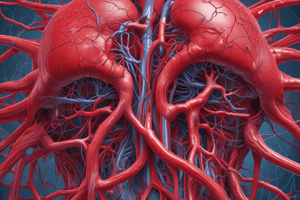Podcast
Questions and Answers
What is the primary characteristic that distinguishes central cyanosis from peripheral cyanosis?
What is the primary characteristic that distinguishes central cyanosis from peripheral cyanosis?
- Location of discoloration (correct)
- Underlying cause
- Duration of discoloration
- Associated symptoms
In vascularity assessment, what condition is indicated by intense redness of the skin due to excess blood in dilated capillaries?
In vascularity assessment, what condition is indicated by intense redness of the skin due to excess blood in dilated capillaries?
- Erythema (correct)
- Jaundice
- Vitiligo
- Pallor
Which condition presents with a decrease in color and paleness due to reduced amounts of oxyhemoglobin?
Which condition presents with a decrease in color and paleness due to reduced amounts of oxyhemoglobin?
- Central cyanosis
- Jaundice
- Pallor (correct)
- Erythema
What is the primary cause of jaundice-related yellow discoloration observed in the sclera, lips, and skin?
What is the primary cause of jaundice-related yellow discoloration observed in the sclera, lips, and skin?
Which condition is characterized by a lack of pigment causing patchy areas on the skin over the face, hands, or arms?
Which condition is characterized by a lack of pigment causing patchy areas on the skin over the face, hands, or arms?
What circulatory changes are indicated by erythema observed in pressure ulcers, fever, and direct trauma?
What circulatory changes are indicated by erythema observed in pressure ulcers, fever, and direct trauma?
What does turgor refer to in relation to the skin?
What does turgor refer to in relation to the skin?
How is turgor assessed in a patient?
How is turgor assessed in a patient?
What does increased or decreased temperature of the skin indicate?
What does increased or decreased temperature of the skin indicate?
What is the normal finding when assessing skin vascularity?
What is the normal finding when assessing skin vascularity?
Which condition may lead to poor turgor assessment where the skin stays tented?
Which condition may lead to poor turgor assessment where the skin stays tented?
What is a possible abnormal finding when assessing skin texture?
What is a possible abnormal finding when assessing skin texture?
What is the purpose of pressing the edematous area firmly with the thumb for 5 seconds and releasing?
What is the purpose of pressing the edematous area firmly with the thumb for 5 seconds and releasing?
Which of the following best describes dependent edema?
Which of the following best describes dependent edema?
What is indicated by a deep pitting score of +3 when assessing edema?
What is indicated by a deep pitting score of +3 when assessing edema?
How does aging affect capillaries in the skin?
How does aging affect capillaries in the skin?
Which of the following describes petechiae based on the text?
Which of the following describes petechiae based on the text?
When assessing edema, what characteristics should be inspected and palpated?
When assessing edema, what characteristics should be inspected and palpated?
Flashcards are hidden until you start studying
Study Notes
Skin Color Alterations
- Central cyanosis: apparent in the lips, oral mucosa, and tongue
- Peripheral cyanosis: appears in the hands, nails, and feet
- Pallor: decrease in color, observable in buccal mucosa, face, conjunctiva, and nail beds
- Loss of pigmentation: vitiligo, a congenital or autoimmune condition causing lack of pigment
- Jaundice: yellow discoloration, usually observed in the sclera, palpebral conjunctiva, lips, hard palate, under surface of the tongue, tympanic membrane, and skin
- Erythema: intense redness of the skin due to excess blood in dilated capillaries
Moisture
- Refers to the wetness and oiliness of the skin
- Indicates body fluid imbalances, changes in the skin's environment, and regulation of body temperature
- Normal findings: smooth and dry with minimal perspiration and oiliness
- Abnormal findings: dullness, excessive dryness, crusting, flaking, scaling, overly moist and cool
Temperature
- Depends on the amount of blood circulating through the dermis
- Increased or decreased temperature indicates an increase or decrease in blood flow
- Normal findings: uniformly warm
- Abnormal findings: generalized warmth in fever and hyperthyroidism, coolness in hypothyroidism, local warmth in inflammation, cellulitis, and pressure ulcers
Texture
- Refers to the character of the skin's surface and the feel of deeper portions
- Normal findings: smooth, soft, even, and flexible in children and adults
- Abnormal findings: scar or hardening (recent skin injury), tenderness or localized areas of induration (hardening) due to repeated IM/SQ injections, roughness in hypothyroidism
Mobility and Turgor
- Turgor is the skin's elasticity, which can be diminished by edema or dehydration
- Mobility is the ease in lifting up the skin when pinching
- Normal findings: skin lifts easily and snaps back immediately to its resting position
- Abnormal findings: skin stays or tented when turgor is poor (e.g. dehydration), decreased mobility in edema, scleroderma
Vascularity
- The circulation of the skin affects the appearance of superficial blood vessels
- With aging, capillaries become fragile
- Abnormal findings: petechiae, tiny, pin-point sized, red-purple spots on the skin caused by small hemorrhages in the skin layers
Edema
- The collection of fluid in underlying tissues that separates the skin's surface from pigmented and vascular layers
- Dependent edema: appears in the feet, ankles, and sacrum
- Pitting edema: residual indentation left by the fingers with pressure when the fluid is displaced from the underlying tissues
- 4-point scale grading in pitting edema: +1 = mild pitting, +2 = moderate pitting, +3 = deep pitting, +4 = very deep pitting
Lesions
- The skin is normally free of lesions, except common freckles or age-related changes
- Inspect the skin for any lesions and describe the findings about any lesion in an orderly fashion: location, distribution, size, arrangement, color, configuration, secondary changes, and presence of drainage
Studying That Suits You
Use AI to generate personalized quizzes and flashcards to suit your learning preferences.




